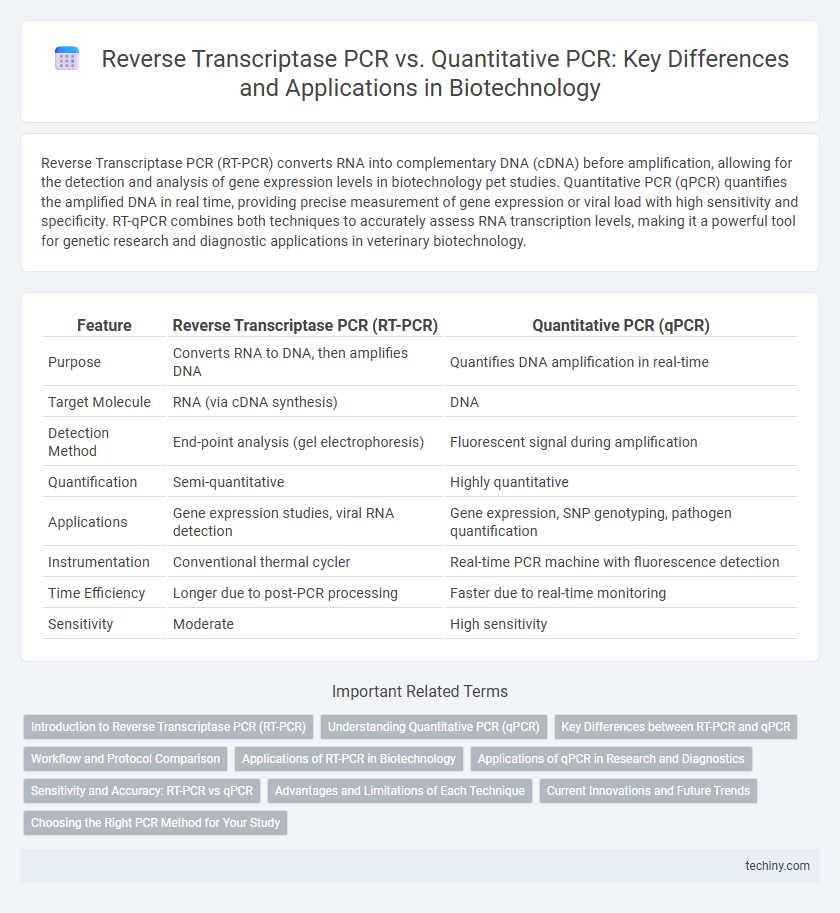Reverse Transcriptase PCR (RT-PCR) converts RNA into complementary DNA (cDNA) before amplification, allowing for the detection and analysis of gene expression levels in biotechnology pet studies. Quantitative PCR (qPCR) quantifies the amplified DNA in real time, providing precise measurement of gene expression or viral load with high sensitivity and specificity. RT-qPCR combines both techniques to accurately assess RNA transcription levels, making it a powerful tool for genetic research and diagnostic applications in veterinary biotechnology.
Table of Comparison
| Feature | Reverse Transcriptase PCR (RT-PCR) | Quantitative PCR (qPCR) |
|---|---|---|
| Purpose | Converts RNA to DNA, then amplifies DNA | Quantifies DNA amplification in real-time |
| Target Molecule | RNA (via cDNA synthesis) | DNA |
| Detection Method | End-point analysis (gel electrophoresis) | Fluorescent signal during amplification |
| Quantification | Semi-quantitative | Highly quantitative |
| Applications | Gene expression studies, viral RNA detection | Gene expression, SNP genotyping, pathogen quantification |
| Instrumentation | Conventional thermal cycler | Real-time PCR machine with fluorescence detection |
| Time Efficiency | Longer due to post-PCR processing | Faster due to real-time monitoring |
| Sensitivity | Moderate | High sensitivity |
Introduction to Reverse Transcriptase PCR (RT-PCR)
Reverse Transcriptase PCR (RT-PCR) is a specialized technique that converts RNA into complementary DNA (cDNA) using the enzyme reverse transcriptase, enabling subsequent amplification of target sequences. This method is essential for analyzing gene expression and detecting RNA viruses, providing qualitative insights into transcript presence. RT-PCR serves as a foundational step in workflows requiring RNA quantification, particularly when studying gene regulation and viral diagnostics.
Understanding Quantitative PCR (qPCR)
Quantitative PCR (qPCR) enables precise quantification of DNA by amplifying target sequences using fluorescent dyes or probes, providing real-time measurement of DNA concentration throughout the amplification process. Unlike Reverse Transcriptase PCR (RT-PCR), which converts RNA into complementary DNA before amplification, qPCR directly quantifies DNA, making it ideal for gene expression analysis, pathogen detection, and genetic variation studies. The sensitivity, specificity, and dynamic range of qPCR make it a critical tool in molecular biology and clinical diagnostics.
Key Differences between RT-PCR and qPCR
Reverse Transcriptase PCR (RT-PCR) converts RNA into complementary DNA (cDNA) using reverse transcriptase before amplification, primarily for detecting and qualitatively analyzing gene expression. Quantitative PCR (qPCR), also known as real-time PCR, measures the amplification of DNA in real-time, enabling precise quantification of nucleic acid levels. The key difference lies in RT-PCR focusing on RNA detection through cDNA synthesis, while qPCR provides quantitative data on DNA concentration during amplification cycles.
Workflow and Protocol Comparison
Reverse Transcriptase PCR (RT-PCR) involves converting RNA into complementary DNA (cDNA) before amplification, making it essential for gene expression analysis, while Quantitative PCR (qPCR) enables real-time quantification of DNA during amplification using fluorescent dyes or probes. RT-PCR protocols include RNA extraction, reverse transcription, and conventional PCR amplification, typically requiring gel electrophoresis for product detection. In contrast, qPCR workflows combine amplification and detection in a single step, providing faster results and high sensitivity through cycle threshold (Ct) value measurement without post-PCR processing.
Applications of RT-PCR in Biotechnology
RT-PCR is extensively used in biotechnology for gene expression analysis, enabling the detection and quantification of RNA transcripts to study cellular responses and disease mechanisms. It plays a crucial role in validating gene knockdown or overexpression experiments and detecting viral RNA in clinical diagnostics. Quantitative PCR, in contrast, provides precise quantification of DNA amplification, often used for genotyping and absolute quantification of nucleic acids.
Applications of qPCR in Research and Diagnostics
Quantitative PCR (qPCR) provides precise quantification of nucleic acids, making it essential for gene expression analysis, viral load detection, and mutation quantification in both research and clinical diagnostics. Its ability to monitor amplification in real-time allows for accurate monitoring of pathogen levels in infectious disease diagnostics and facilitates high-throughput screening in cancer biomarker discovery. qPCR's sensitivity and specificity enable early disease detection and personalized treatment strategies, outperforming Reverse Transcriptase PCR (RT-PCR) in quantifying RNA targets with higher resolution.
Sensitivity and Accuracy: RT-PCR vs qPCR
Reverse Transcriptase PCR (RT-PCR) converts RNA into complementary DNA (cDNA) before amplification, offering high sensitivity for detecting low-abundance transcripts but with limited quantitative accuracy. Quantitative PCR (qPCR) enhances accuracy by monitoring DNA amplification in real-time using fluorescent markers, providing precise, reproducible quantification of target nucleic acids. qPCR surpasses RT-PCR in both sensitivity and accuracy, making it the preferred method for gene expression analysis and viral load quantification in biotechnology.
Advantages and Limitations of Each Technique
Reverse Transcriptase PCR (RT-PCR) enables the detection and quantification of RNA by converting it into complementary DNA, offering high sensitivity for gene expression analysis but is limited by its qualitative output and susceptibility to contamination. Quantitative PCR (qPCR) provides real-time measurement of DNA amplification, delivering precise quantification with high reproducibility, but requires specialized fluorescent probes and is sensitive to PCR efficiency variations. Choosing between RT-PCR and qPCR depends on the need for either endpoint detection or dynamic quantification, with considerations for accuracy, cost, and experimental complexity.
Current Innovations and Future Trends
Reverse Transcriptase PCR (RT-PCR) innovations include highly sensitive enzyme formulations and digital RT-PCR platforms enabling absolute quantification of RNA transcripts. Quantitative PCR (qPCR) advancements focus on multiplexing capabilities and integration with microfluidic chips for high-throughput gene expression analysis. Future trends highlight AI-driven data interpretation and portable point-of-care devices enhancing real-time molecular diagnostics in biotechnology.
Choosing the Right PCR Method for Your Study
Reverse Transcriptase PCR (RT-PCR) is essential for detecting and analyzing RNA expression by converting RNA into complementary DNA, while Quantitative PCR (qPCR) quantifies DNA or cDNA in real-time to measure gene expression levels with high sensitivity and specificity. Selecting the appropriate PCR method depends on the study's objective: RT-PCR is ideal for qualitative assessment of gene presence or transcript variants, whereas qPCR is preferred for precise quantification of gene expression changes under various experimental conditions. Understanding the differences in sensitivity, data output, and target nucleic acid type ensures accurate molecular analysis tailored to specific research needs in biotechnology.
Reverse Transcriptase PCR vs Quantitative PCR Infographic

 techiny.com
techiny.com